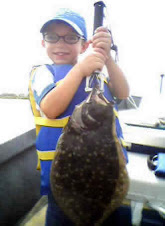Fishing was slow. An hour of drifting slowly across the shallow grass flats in my kayak with methodical casts to sand holes and other likely looking spots had not produced one strike.
Then the lure stopped.

Not a hard strike or a jerk. It just felt like grass on the lure.
I set the hook hard and the rod bent like a bow.
The fish stayed deep, hugging the bottom. It had to be a flounder.
As the fish neared the kayak, the big flatfish rolled on the surface and made a power run.
This was my Clint Eastwood fish. Only one fish all day can “make my day” and that’s a big southern flounder.
With the landing net lying in my lap, I eased the big flounder near to the kayak. Then he made a sharp turn and began to peel out again. That’s when the jig head popped out of his mouth and flew over my head.
Heartbreak.
I already had visions of Mr. Flounder stuffed with shrimp and crabmeat dressing.
Hooking a flounder is not so common an event as in years past.
For the past 30 years, the southern flounder population along the Texas coast has been in a slow, steady decline. Then the bottom fell out of the numbers in the mid-1990s. This sharp decline in the population really caught the eye of Texas Parks and Wildlife biologists.
Changes to the fishing regulations, like raising the minimum keeper size from 12 to 14 inches, didn’t seem to help much. The decline continued right on into this decade, with no end in sight.
At public meetings in November 2008, the biologists explained the severity of the situation that was told by years of research data. A potential collapse of the entire flounder population on the Texas coast was just around the corner.
In March 2009 some radical recommendations were presented to the Texas Parks and Wildlife Commission. Bag limits were to be reduced for both commercial (30) and recreational fishermen .
The most radical recommendation was a total close of flounder harvest in the month of November.
The majority of flounder caught on the Texas coast are taken in the peak spawning month of November. This is the month that the biggest numbers of flounder migrate from the bays to the Gulf through fish passes and jetties.
Recreational flounder giggers stick lots of flatfish on cold November nights. Memories of dozens of giggers carrying Coleman lanterns near the Port Aransas Ferry landing are vivid in the memories of many of us.
The commission adopted all the recommended changes with the exception of one. Fishermen will be allowed to retain two flounder per day in November.
This concession was primarily made because of economic consideration. Flounder fishing in November is big business in coastal towns and cities during that key month.
Without the possibility of keeping any fish most retail stores would feel the loss of business big time.
These changes that went into effect Sept. 1 should produce great results. Flounder grow fast. Their life span is only six years.
“We expect that after one generation has passed through the new system (or about six years), the spawning stock biomass of flounder will increase by roughly 80 percent of early 1980s population levels,” Art Morris, fishing specialist at TPWD’s Corpus Christi Field Station, said.
He added, “Due to the fast-growing nature of the species, two years after implementation, we should see about 85 percent of the benefits of the new regulations.”
Let’s hope it works. Flounder is still my favorite to catch and eat.
Jim Darnell is an ordained minister and host/producer of the syndicated television show “God’s Great Outdoors.” His column appears every Thursday in the Daily Record.







